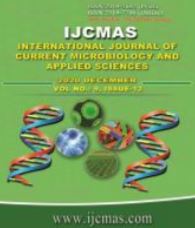


 National Academy of Agricultural Sciences (NAAS)
National Academy of Agricultural Sciences (NAAS)

|
PRINT ISSN : 2319-7692
Online ISSN : 2319-7706 Issues : 12 per year Publisher : Excellent Publishers Email : editorijcmas@gmail.com / submit@ijcmas.com Editor-in-chief: Dr.M.Prakash Index Copernicus ICV 2018: 95.39 NAAS RATING 2020: 5.38 |
This study was conducted in Al-Ain (Abu Dhabi Emirate) at the Police Dogs Unit K9, to detect the load of bacterial contamination at the critical control points of canine feeding process and these are kennel floor, handlers’ hands, the bowls before and after meal and meat canned food. A number of 300 swabs samples were taken from the five points on duration of ten consecutive weeks. The samples were sent to the Central veterinary laboratory for microbiological analysis. The results displayed a variety of contaminants were identified at the stages of the feeding processes, a highest bacterial viable counts were at the kennel floor (4.21 log10cfu/cm2) and the Bowls after meal (5.05 log10cfu/cm2), while the low or nearly neglected bacterial count was in the canned food (0.78 log10cfu/cm2). Accordingly, Staphylococcus aureus and Escherichia coli were seen at lower mean bacterial count at points of handlers’ hands (0.34%, 0.06%) and canned food (0.00%, 0.06%), while they were highest at the kennel floor (25.54%, 60.05%) and the Bowls after meal (70.89%, 36.46%), respectively. This study has shown that the highest bacterial contamination in Police dogs' feeding processes is at the bowls after meal and kennel floor and the lowest at the handler’s hands and the canned food, and also that Staphylococcus aureus and Escherichia coli were the major pathogenic contaminants in the feeding processes.
 |
 |
 |
 |
 |